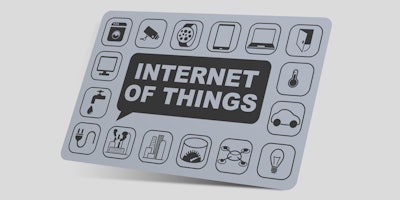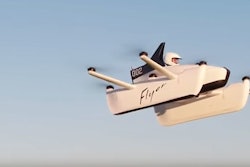
 Mike Edgett
Mike EdgettThe Internet of Things (IoT) is one of the most hyped technology trends in decades. It is also one of the least understood. Some enterprises have turned to IoT technology as the cure-all treatment for every manufacturing ailment, from volatility in the supply chain to customer demands for new product offerings. Overly inflated expectations cause frustrations. On the opposite side, enterprises can also under-appreciate the potential of IoT technology, missing out on the possible benefits that can help drive return on investment (ROI).
While the food and beverage industry has its fair share of early IoT adopters, many companies are still stalled by technology overload and indecision. As the digital evolution sweeps through manufacturing, the pressures to modernize and invest in advanced technology can be overwhelming. But where do you start?
On The Farm
The product lifecycle for the food and beverage industry is typically long. It can have many circuitous routes and navigate detours caused by weather, seasonal variability, ingredient availability or sudden shifts in demand. However, this journey often starts on the farm. The agriculture industry is under immense pressure to control costs and boost yield. Technology — including IoT — has proven to be invaluable in achieving this.
With farmers facing unprecedented cost pressures and new trade wars and tariffs, boosting yield is a high priority — and any extra advantage helps. Sensors are being used to monitor weather conditions, the moisture level of soil, crop maturity and even the presence of insects or fungus. Soil and moisture sensors in fields help to optimize irrigation, and these sensors can automate the switching on and off of systems as needed. Monitoring soil can also help determine when and where fertilization is needed. These tools take the guesswork out of managing processes and making a science out of maximizing the crop yield per acre.
For farms with livestock, sensors can monitor herd weight and other signs of herd health, such as milk production in dairy cows. Sensors and timers can also automate feeding cycles, controlling the diet of the animals as needed. Breeding can also benefit from controlled environments — including brooding barns and hatcheries which require strict temperature control.
Additionally, smart technologies have also found a place in farm equipment. While self-driving cars may still seem futuristic, agricultural equipment has leveraged smart technology for some time. GPS tracking is being used to aid in everything from planting straight rows in the field to optimizing the position of irrigation equipment. Today, drones have been added to the list of tech solutions that can be utilized by tech-savvy farms to remotely inspect and monitor field or building conditions.
Sensors embedded in the farm machinery can also be used to monitor machine performance and detect early warning signs of equipment that may need preventive service. Farm equipment today is highly complex and represents sizable capital investments. Therefore, it makes sense to do everything possible to extend the lifecycle of the equipment though smart maintenance.
IoT technology also helps maintenance by tracking the physical location of assets. Today’s farms can be massive. Many are spread over miles of land with multiple similar pieces of machinery in operation at once. Being able to find the machinery — and operator — is always helpful and offers a layer of safety precaution. Technology helps make service a science, not an afterthought.
The insight gained by adopting new sensor-driven practices is only valuable if fed into systems that facilitate predictive analytics. These insights should then be used to make better, more informed decisions about future activities. Through gaining greater control and predictability over farming practices, opportunities are easier to exploit and margins are maximized. Data trends, collected from sensors, can be used to spot early warning signs while intervention is still possible. Early warning signs of equipment failure or declining herd health can be detected from anomalies in sensor data. When warning signs are caught early, prevention or intervention tends to be more effective.

At The Table
It is also important to look at the other end of the supply chain — the consumer. If you take a broad view of IoT, it is fundamentally the idea of utilizing sensor-embedded technologies to capture, analyze and transmit volumes of data from various sources. For example, Smart Label is an initiative spearheaded by the Grocery Manufacturers Associations (GMA) along with a number of consumer product manufacturers. It enables consumers to have easy and instantaneous access to detailed information about thousands of products.
This information — which can be found by scanning a QR code — includes details on nutrition, ingredients, allergens, third-party certifications, social compliance programs, usage instructions, advisories and safe handling instructions. It is reasonable to assume that the depth of information about the product could even include where each of these ingredients came from and how old each ingredient was before being utilized, along with a host of additional data points that could never fit on a label.
In The Plant
It can be argued that the plant floor is where the most important benefits of IoT technology can be found. Here, manufacturers are investing in sensors and predictive analytics to embrace IoT insights. As machines, processes and people on the plant floor become more connected, the value of IoT becomes more apparent. It can drive quality improvements, boost efficiency and accelerate time to market for new offerings. Access to this data in consumable formats makes it possible.
About Compliance And Safety
The role that IoT has played, and continues to play, for companies as they fine-tune their Food Safety Modernization Act (FSMA) plans has been a common topic for several years. The foundation of FSMA is the need to have proactive plans in place to prevent quality and safety issues. A prerequisite is the means to collect data that could give insight to a potential problem before it occurs. The use of real-time temperature sensors throughout the manufacturing and distribution of products can help companies not only see when a problem has occurred but also better forewarn of pending problems when patterns begin to change. A fully integrated solution will also enable food processors to know exactly when products are suspect so they can be isolated.
Empowering People
IoT technology plays an important role in improving the productivity and efficiency of the workforce. This is an area which receives much attention — and investment.
An example of this is the use of wearables throughout the plant. Although early prototypes of high tech glasses did not live up to the hype in the consumer market, the technology is successfully being used in plants. A maintenance worker can have instructions on how to repair or maintain a piece of equipment overlaid within the safety glasses he or she is already wearing. Or, looking at a machine part can trigger a visual dashboard of the part’s lifecycle and service history, along with when it is due to be replaced. Such insights, brought to the user when and where they are needed, can be helpful for workers in locations where it is not convenient to access a workstation or carry a smart tablet. In locations with inherent safety issues — such as high temperatures, high towers or sharp blades — being able to access important data hands-free allows the technician to focus on the job, not on the IT device’s keyboard.
The “thing” in the Internet of Things for food and beverage will likely continue to be the things in the manufacturing plant — the sensors in tanks, vessels, pumps and filling lines. The most obvious business case will center around efficiency and margin improvement. But the business case can be so much more. IoT can also be a driver for better quality and compliance, and it can enable innovation and better communication with your customers. This will require broadening the “things” to also include processes, machinery and the workforce. Then, IoT can reach its full farm-to-fork potential.
Mike Edgett is Director of Industry & Solution Strategy – Process Manufacturing, at Infor.























